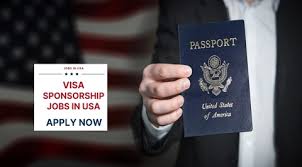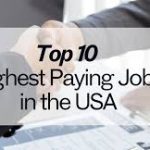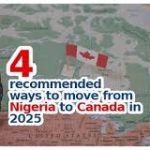$50,000 USA Visa-Sponsored Jobs Opportunity in 2025 — A Complete Guide
Breaking into the U.S. job market with employer visa sponsorship is a realistic goal — and a lifeline — for many international professionals.
This article explains how to find visa-sponsored jobs that pay around $50,000 (or more) in 2025, demystifies the sponsorship process, highlights industries and roles where this salary is common, and gives practical, step-by-step advice to help you get hired and relocated.
Whether you’re early in your career or a mid-level professional, this guide equips you with actionable strategies, timelines, and checklists so you can pursue U.S. opportunities with confidence.
Quick reality check: what “$50,000 jobs” means in 2025
A salary of $50,000 per year is a realistic entry-to-mid level wage for many occupations in the U.S. In some regions (large coastal metros) it’s closer to entry level.
while in lower cost areas it’s solid mid-level pay. Importantly, many visa pathways for employers (H-1B, EB categories, etc.) commonly support jobs that pay $50,000 or more, especially for professionals with technical skills, healthcare backgrounds, or specialized trades.
Why this matters: if your goal is sponsorship, you’ll want to target roles that match both your skills and the kinds of positions U.S. employers sponsor — the better the fit, the higher your chances.
Common visa categories employers sponsor (simple overview)
Understanding the visa types helps you target the right employers and jobs.
-
H-1B (Specialty Occupation)
-
For jobs that require a bachelor’s degree (or equivalent) and specialized knowledge. Employers file petitions on behalf of the worker. Often used by tech companies, engineering firms, research labs, and some finance/consulting roles.
-
-
H-2B (Temporary non-agricultural workers)
-
For seasonal or temporary roles (hospitality, landscaping, certain skilled positions). Employers must show a temporary need.
-
-
L-1 (Intracompany transferee)
-
For employees of multinational companies being transferred to a U.S. office. Useful if you already work for a company with U.S. presence.
-
-
TN (NAFTA/USMCA professionals)
-
For Canadian and Mexican citizens in listed professions (engineers, scientists, accountants, etc.). Quick and employer-friendly for eligible nationals.
-
-
Green Card employment-based routes (EB-2, EB-3, PERM labor certification)
-
Longer term sponsorship that leads to permanent residency. Employers often sponsor these for mid/senior roles.
-
-
Other temporary visas
-
O-1 for individuals with extraordinary ability, OPT for recent F-1 graduates (temporary work authorization), and J-1 for exchange visitors. Some of these are stepping stones toward employer sponsorship.
-
Industries and job families where $50,000+ sponsorships are common
If targeting sponsorship, prioritize industries that historically sponsor foreign talent and where $50,000+ is standard for entry/mid levels:
-
Information Technology (IT) & Software Development
-
Job titles: Software developer, QA engineer, systems administrator, data analyst. Many companies sponsor H-1B petitions for these roles.
-
-
Healthcare & Allied Health
-
Job titles: Registered Nurse (with state licensing), physical therapist, medical technologist. Hospitals and healthcare systems often hire internationally for shortages.
-
-
Engineering (Mechanical, Electrical, Civil)
-
Job titles: Design engineer, field engineer, project engineer. Engineering roles with degree requirements fit H-1B/EB categories.
-
-
Skilled Trades & Construction (where H-2B or employer arrangements exist)
-
Job titles: HVAC technician, welder, heavy equipment operator. These roles sometimes use temporary worker programs or direct sponsorship.
-
-
Education & Research
-
Job titles: Research assistant, lab technician, adjunct instructor — especially at universities with international collaboration.
-
-
Finance & Business Services
-
Job titles: Business analyst, compliance associate, operations analyst — smaller numbers of sponsors but still possible.
-
-
Hospitality, Logistics, Agriculture (seasonal H-2B/H-2A)
-
These sectors frequently hire foreign workers for temporary needs.
-
Roles that often start near $50,000 (examples)
These are examples of entry or junior roles that commonly have base pay around $50,000 (region and company dependent):
-
Entry-level software engineer / junior developer
-
Data analyst (junior)
-
Registered nurse (depending on state and shift differentials)
-
HVAC technician / electrician apprentice (experienced apprentices)
-
Project engineer (junior)
-
Lab technician / clinical lab scientist
-
Technical support engineer (mid level)
-
Operations analyst / supply chain associate
Targeting similar titles lets you align expectations and search where sponsorship is realistic.
How employers decide to sponsor someone
From an employer’s perspective, sponsorship is an investment. They consider:
-
Necessity: Is this a role that requires specific skills or a degree they cannot easily find locally?
-
Cost/benefit: Sponsorship has legal fees, paperwork time, and sometimes travel. Is the candidate worth it?
-
Likelihood of approval: Does the job clearly match visa rules (e.g., H-1B specialty occupation)?
-
Retention probability: Will the hire stay long enough to justify sponsorship?
-
Company size & experience: Larger employers or those with HR/legal teams sponsor more readily.
Your job in the application is to demonstrate clear, documented value that makes sponsorship the smart business choice.
Step-by-step strategy to land a $50,000+ sponsored role
1. Clarify your strengths and immigration eligibility
-
Inventory your skills, degrees, certifications, and language ability.
-
Identify visa categories you qualify for (e.g., do you have a U.S. degree or OPT? Are you from Canada/Mexico for TN?).
-
If you’re unsure about legal details, plan a short consult with an immigration attorney — this can save time later.
2. Build a sponsorship-friendly resume and LinkedIn profile
-
Emphasize measurable results and technical keywords from job descriptions.
-
For H-1B or other degree-based visas, highlight your education (degree, major, institution, graduation date) and exact job-relevant coursework or projects.
-
Add a concise statement in your LinkedIn summary like: “Open to employer-sponsored opportunities in [field]; authorized to [current work authorization status]” — be transparent about visa needs without making it the lead.
3. Target the right employers
-
Prioritize companies with a history of sponsorship: large tech firms, hospitals, universities, and certain manufacturing firms.
-
Also target medium-sized companies in your industry that have previously sponsored visas (use job boards, forums, or alumni networks to find them).
-
Consider multinational employers where you might transfer internally (L-1 route).
4. Use the right job search channels
-
Company career pages and LinkedIn are primary. Use filters like “willing to sponsor” where available.
-
Specialized job boards and recruitment agencies help: look for “visa sponsorship” keywords.
-
University alumni networks, professional associations, and international student groups are powerful referrals.
5. Craft tailored applications
-
For each application, customize your resume and cover letter to the job description. Use the same keywords and show how your background solves a concrete problem for the team.
-
Explicitly note if you need sponsorship and the earliest start date you can have (if known), but keep the focus on value.
6. Prepare for interviews with an employer-focused pitch
-
Practice describing technical achievements, problem solving, and measurable impact.
-
Prepare concise explanations of your immigration situation: e.g., “I will require employer sponsorship; my current status is X, and I’m familiar with the process.” This shows you understand and reduces employer uncertainty.
7. Negotiate a compensation package smartly
-
Remember salary is only one component — consider health benefits, relocation support, visa legal fee assistance, and paid time off.
-
If the employer is unsure about sponsoring, offering to cover part of the initial paperwork (or to contribute to relocation costs) can be a negotiation lever — but never promise to pay for legal fees you’re not prepared for.
8. Once an offer arrives, confirm sponsorship details
-
Ask for a written statement that the company will sponsor the visa (and which visa).
-
Clarify timeline, who pays legal fees, and contingency plans if the petition is delayed.
-
Engage a qualified immigration lawyer if needed.
Practical application tips — resume, cover letters, and interviews
-
Resume: 1–2 pages; bullet points with achievements; include metrics (e.g., “Reduced build time by 30%”; “Handled X patient visits weekly”). Use industry keywords to pass ATS (applicant tracking systems).
-
Cover letter: One page; open with a problem you solved that’s directly relevant to the company; close with a short sentence about sponsorship needs (tactfully).
-
Interview: Prepare STAR (Situation, Task, Action, Result) stories; have examples ready for teamwork, conflict resolution, and technical problem solving. For visa questions, answer succinctly and confidently — employers respect clarity.
How to find companies likely to sponsor
-
Large tech and finance firms: often sponsor, especially for technical roles.
-
Academic institutions and hospitals: frequently sponsor clinical and research staff.
-
Staffing agencies and specialty recruiters: some agencies place international workers and coordinate sponsorship logistics.
-
Smaller companies with global operations: may sponsor if they can’t find local talent.
Costs, timelines, and who pays what
-
Costs: Employers usually pay the bulk of H-1B and PERM green card costs. Some smaller employers may ask employees to cover certain fees, but best practice and many immigration rules require employer payment for core filing fees.
-
Timeline: Varies. H-1B can depend on annual lottery cycles; L-1 depends on company processing; PERM green card processes take months to years. Expect anywhere from a few weeks (TN) to many months (PERM/EB) for full processing.
-
Start dates and contingencies: Discuss early. Some companies will offer conditional start dates subject to visa approval.
Common employer concerns — and how to address them
-
“Sponsorship is expensive and slow.”
-
Response: Demonstrate you are a low-risk hire: strong track record, quick onboarding plan, and clear job match. Offer examples of projects you can deliver in the first 90 days.
-
-
“Will the person stay long term?”
-
Response: Emphasize commitment: career goals, why the company, and steps you’ll take to integrate. If relevant, mention openness to EB sponsorship for long-term retention.
-
-
“Will the candidate be able to handle relocation and cultural fit?”
-
Response: Share experiences working in diverse teams, language fluency, and willingness to relocate quickly.
-
Negotiating salary and sponsorship support
-
Know your market: Research typical salaries for the role and geography. Use salary calculators and regional data to set targets.
-
Be realistic but firm: For roles around $50,000, focus on total compensation (health, relocation, signing bonus) not just base pay.
-
Ask for visa help explicitly: Request company support for filing fees, attorney fees, and reasonable relocation assistance. Put sponsorship terms in the offer letter.
Mistakes to avoid
-
Applying broadly without customizing applications.
-
Hiding sponsorship needs until late in process — transparency is better.
-
Accepting vague verbal promises about sponsorship; insist on written commitment.
-
Assuming every U.S. employer will sponsor — they won’t. Target those with demonstrated history.
-
Not understanding the visa timeline — some employers can’t wait months for approvals.
Sample timeline (typical scenario for H-1B / employer sponsorship)
-
Weeks 0–2: Job search, apply, screening interviews.
-
Weeks 2–8: Technical/behavioral interviews and offer negotiations.
-
Offer made and accepted (Week 8–10): Employer confirms sponsorship intent and engages immigration counsel.
-
Filing stage (Week 10–14): Employer prepares and files petition (H-1B or PERM start).
-
Processing (Weeks 14–varies): USCIS and consulate processing; optional premium processing can shorten certain waits.
-
Start date: Upon approval and visa stamping (if outside U.S.). Timelines vary — be prepared for delays.
What employers usually ask in the visa clause of an offer
-
Which visa the employer will sponsor (H-1B, L-1, EB-3, etc.).
-
Who will pay legal and filing fees.
-
Whether the start date depends on visa approval.
-
Whether relocation assistance will be provided.
-
Confidentiality and job duties description (helpful for filing).
Practical case studies (hypothetical, anonymized)
Case A: Junior Software Engineer from Nigeria
-
Background: Bachelor’s in Computer Science, 2 years’ experience, strong portfolio.
-
Strategy: Applied to several mid-sized tech firms with “willing to sponsor” tags, highlighted cloud and backend projects, obtained a technical interview, negotiated offer that included H-1B sponsorship and partial relocation.
-
Result: H-1B petition filed by employer; premium processing used; candidate started within 6 months.
Case B: Registered Nurse from the Philippines
-
Background: Nursing degree, passed NCLEX, willing to relocate anywhere in the U.S.
-
Strategy: Worked with a hospital system that recruits internationally, employer managed visa paperwork and licensing steps.
-
Result: Sponsorship included visa support and relocation; started with a guaranteed orientation and mentorship program.
These examples show different routes — tech through H-1B and healthcare through employer recruitment programs — both can lead to $50,000+ compensation depending on role and locality.
A pragmatic checklist before applying
-
Have a clear, targeted resume with role-relevant keywords.
-
Updated LinkedIn profile that states openness to sponsorship.
-
List of 25 target companies (mix of large, medium, and niche employers).
-
3 tailored cover letters ready.
-
Portfolio or GitHub (for tech) or licensing/certificates (for healthcare/trades).
-
Savings buffer to cover short-term relocation costs if needed.
-
Contact with an immigration attorney (optional but recommended).
-
References ready and informed about potential U.S. employer checks.
Frequently asked questions (FAQs)
Q: Will employers pay for my entire visa process?
A: Many reputable employers pay core filing and attorney fees for H-1B and PERM/EB processes. Some smaller employers may expect more negotiation. Always get specifics in writing.
Q: Can I apply while in my home country?
A: Yes. Employers can hire and sponsor candidates abroad. If approved, you’ll receive a visa stamp at a U.S. consulate before travel.
Q: What if my job offer is below $50,000?
A: Decide whether the role is a strategic stepping stone. Sometimes a lower entry salary plus sponsorship and U.S. work experience accelerates long-term earnings. Negotiate non-salary benefits.
Q: How do I prove I’m worth sponsorship?
A: Demonstrate unique skills, measurable achievements, and direct alignment with the job’s needs. Provide references and a portfolio when relevant.
Q: Is it easier to get sponsored for certain locations?
A: Employers in high-demand tech or specialized sectors (urban hubs) sponsor more, but competition is higher. Smaller cities may offer quicker paths and lower living costs.
Final tips — stand out and be persistent
-
Network relentlessly. Referrals significantly increase chances of sponsorship. Use alumni networks, LinkedIn, conferences, and professional groups.
-
Show business impact. Employers sponsor people who will move the needle. Quantify your contributions.
-
Be visa-savvy. Know the basics of the visa you need so you can answer employer questions confidently.
-
Be flexible about location. Moving outside expensive coastal metros can improve job and sponsorship prospects.
-
Keep learning. Certifications, short courses, and visible projects make you an easier hire.
Conclusion
Securing a $50,000+ employer-sponsored job in the U.S. in 2025 is achievable with focused strategy, a clear understanding of visa pathways, and disciplined job search tactics.
Target industries that historically sponsor foreign talent, craft application materials that demonstrate measurable impact, and approach employers with clarity about your visa needs.
With preparation, persistence, and the right networking, the U.S. opportunity you’re aiming for can become a practical next step in your career.










